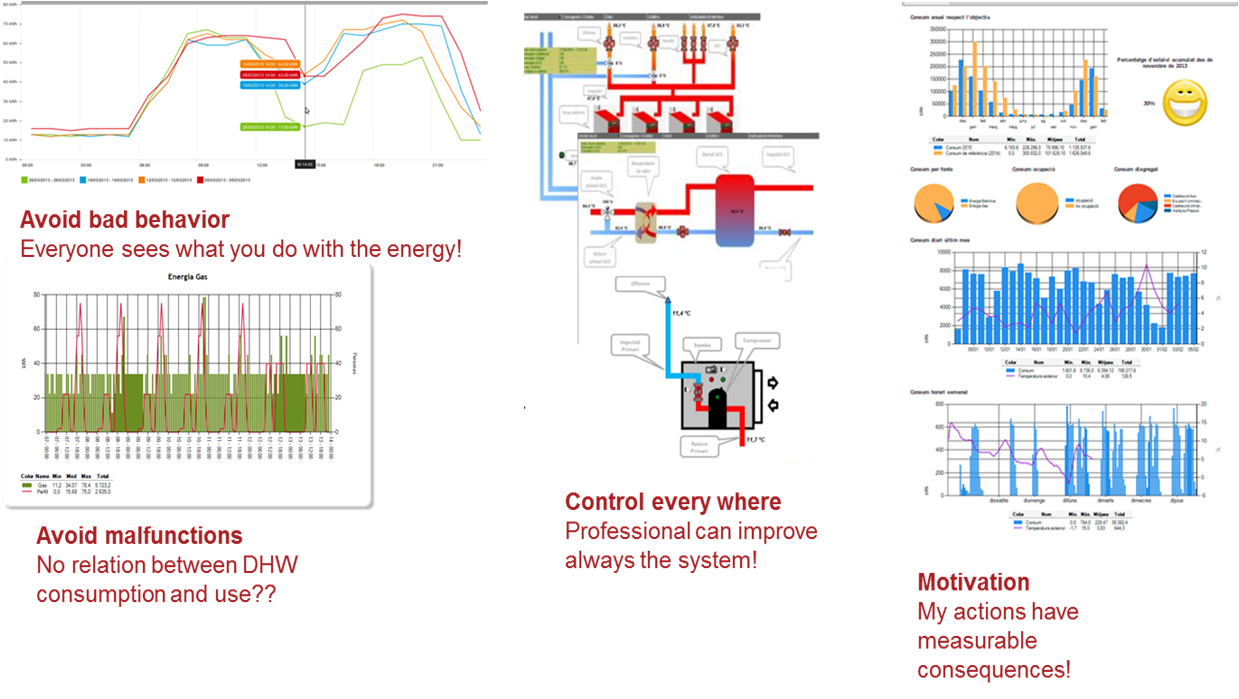Lleida¶
Video – Savings – Service – Cost-Benefit – Exploitation – Partners
There are 22 buildings in the Lleida pilot, comprised of six office buildings, six sports halls, five schools, four cultural centres and one nursing home. The biggest office building is Sant Francesc, used for administration, with 101 staff users and 21,000 visitors per month. Overall savings planned are 15% for buildings with SMARTSPACES services at medium cost, and 5% for low cost model. These buildings are occupied by approximately 700 staff users and 50,000 visitors per month.
Two service levels were deployed: Low with almost no cost (SIE) and Medium with some implementation cost (BEIS). The first service automatically collects monthly billing information in one database. The second service provide more precise, detailed and intelligible information allowing energy managers to make more informed decisions, detect anomalous operation of energy systems earlier and react faster, develop reports and arguments to justify investments in further energy efficiency improvements. The services also provide benchmarking and normalization enabling performance to be compared and therefore rated.
Video¶
Savings¶
For more details visit the eeMeasure tool and the SMARTSPACES deliverable D7.2 also covering qualitative surveys.
Service¶
To login please use the following informtion: Usere:demoBarrisNord, Password:d3m0BarrisNord
edss¶
edss services offered in Lleida differentiate by levels of users and within this level are also differentiate in terms of cost of service. The main edss services offered can be split in the following parts:
- Energy data visualization: to know what is the consumption of our buildings
- Comparison between periods in the same building: to know if we are improving or worsening the consumption of the building.
- Benchmarking between other buildings (same typology): to have some references to know if the consumption that we have are in the correct range.
- Alarms: to control the deviations of the consumptions.
- Reports: to processed information of the consumption of the buildings.
- Energy coach: communication with energy experts that help the users to implement the necessary action to improve the building consumption.
ems¶
Implementation of ems in Lleida follows the logic of two levels of initial economic investment. For the case of Medium cost service (based on hourly data) all buildings has received the complete set of our ems. In case of Low cost service (based on monthly data) the implementation of this type of service is more difficult due to the data granularity. However, some specific ems Service has been given in particular Low cost service buildings, optimising the regulation and the control system of some buildings, and providing alerts and personalized advice.
The medium cost service can gather all the energy data in one point with internet access, i,e. facilitates centralised control of data. The building professional can control through the visualized dashboard or alarm system. In some cases, the alarm signal could be one signal that is necessary to act over some facility of the building, this actuation can be do it manually or automatic.
The system allows control some parameters of the facility that can be do it in a local level, for example, some staff building or building manager people can have access to control in only one zone of the building, whereby the system can give them access to control the temperature, the electric consumption, etc, only for their own zone. The system can be extended by prediction and management of renewables (production) resources.
Value propositions¶
Independent of the number of buildings a council wants to pilot the system with it will immediately allow comparison with, currently, over 200 buildings. The cloud based system is open to any kind of data and provides one output for all professional (and staff) user independent behind which “closed shop” they are sitting with regard to hardware. The comparability is also available for administrative staff, executives and all other staff. For instance, the predicted cost and the actual spending are available at all time. This enables the definition of KPIs and automatic alarms for measuring the performance of buildings. All this can be achieved without involving the measurement provider(s).
Behavioural decision support is rolled out in waves targeting certain aspects of energy (e.g. natural ventilation) as well as being always available in the portal. Since cause and effect are explained and visible in the portal many staff have learned the link to their personal decision. Moreover, the staff learnt to recognise smaller faults and other causes which might only be detected much later by professionals. Since staff now know how and when to contact professionals almost all kind of wastage can be detected early even if the resolution in the number of zones remains small.
Cost-Benefit¶
The SMARTSPACES project has a satisfactory socio-economic return after the implementation of the edss and ems in the buildings of the Lleida pilot site. The business model is based on the Council financing the investment of additional equipment during implementation and consulting cost via fees displacing (currently non-competitive) fees paid to the Energy stakeholder. The absolute savings can easily be increase by upgrading the buildings to a ems service based on energy smart remote energy management devices which requires additional investments but can double the saving potential.
Exploitation¶
The goal of the service provider (CIMNE, Inergy) is to extend the implementation of the SMARTSPACES energy services to the whole of the Catalan public sector, and particularly to the local administration. The business approach is to offer an optimal cost-effectiveness combination of the services developed in the pilot project of Lleida: (a) the low-cost edss based on SIE; (b) the medium-cost edss and ems based on monitoring solutions; and (c) the ems based on energy smart remote energy management devices.
The approach to the customer will be made by an initial offer of the low-cost edss for 100% of its buildings. This first implementation will permit to achieve savings in the energy bill that will generate customer confidence and financial resources to invest in other measures. On the other hand, this first implementation will allow having a full energy accounting of all the park of buildings to identify those with more global consumption and potential savings.
In a second step we provide both, a medium-cost edss and ems for 20-30% of the buildings of the client and the ems based on energy smart remote energy management devices for another 5-10%, which will be chosen according to consumption and identified potential savings.
We are proposing two different schemes of remuneration according to customer requirements: (1) fixed rate according to the level of service performed; (2) variable remuneration linked to savings achieved (ESCO scheme). This second option is proposed exclusively for ems based on energy smart remote energy management devices to reduce the uncertainty and risk of the financial investment.
It is planned for 2015 to extend in the city of Lleida the implementation of the SIE for the whole of the buildings of the city council, and gradually expand for the next years to 50 buildings with medium-cost edss and ems, and up to 10 buildings with ems based in intelligent energy smart remote energy management.
At the Catalonian level, the business goals for the next three years is to achieved the implementation of the low-cost edss based on SIE in 200 municipalities, the implementation of the medium-cost-edss and ems in the 20% of those municipalities, and the introduction of the ems based on energy smart remote energy management devices to a 10% of those municipalities with SIE.





